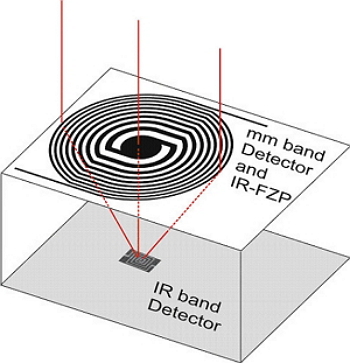DOUBLE BAND DETECTOR FOR THE INFRARED AND TERAHERTZ RADIATION
|
Description |
Two researchers from the Applied Optics Complutense Group of the UCM and the Autonomous University of San Luis Potosí (México) have developed a device that is able to detect electromagnetic radiation from two spectral bands quite apart one from each other. This element produces a signal in the infrared and also in the Terahertz bands. This same idea is applicable to detect simultaneously radiation in the far infrared and the visible range. This double-band detector can also be arranged within a focal plane array in an image-forming system and it is protected by means of patent application. The technology is scalable and applicable for a variety of formats and application, ranging from remote sensing, sensor fussion, multispectral imaging, and single detector applications.
|
How does it work |

Three dimensional arrangement of the detector device of double band on a silicon wafer. Above, the detector low frequency/antenna; below, the high-frequency detector.
Being able to detect electromagnetic radiation at different bands is an important feature when dealing with sensor fusion in the visible, infrared and terahertz radiation. Each band provides complementary information that, when collected and merged together makes possible a full characterization of the scene. Applications are being developed in biomedicine, defense and security, industrial inspection systems, and aerospatial industries.
The objective with this technology is expand the electromagnetic range able to be detected by a given instrument. The element is made of an optical antenna tuned at the low frequency range of the two detected bands. For example, the antenna can be sensible to the Terahertz range. This antenna is having the shape of a Fresnel lens that collects the incoming radiation of the high-frequency band, for example the infrared. In this example, an infrared detector is placed at the focal point of the Fresnel lens. This high-frequency transducer can be realized as a bolometer or a semiconductor detector. By using the low-frequency antenna as a diffractive element we merge together two-functions in one single structure: detection, and collection. The high and low frequency bands can be up two orders of magnitude apart in frequency. For example: terahertz (around 100 GHz) and far infrared (10 THz) or far infrared (10 THz) and visible (100 THz).
Each involved band is able to produce different scenes in a variety of conditions: low visibility, rain, clouds, thermal imaging, etc.
|
Advantages |
- Simultaneous detection of two electromagnetic bands quite different.
- On axis alignment and detection for both bands. This capability makes possible to use the same optical axis for the imaging optics at both wavelengths. Then, the field of view is the same and no further field correction is necessary.
- Both detectors are fabricated on axis on the same wafer.
- The high-frequency detector incorporates a collection optics in form of a diffractive element.
- The design is flexible and adaptable to any given application or system.
|
Where has it been developed |
This device has been developed thanks to a close collaboration between our group and the group of Prof. Javier González, at the Autonomous University of San Luis Potosí. This collaboration is still in place and has made possible a large number of academic collaborations and exchange of students and professor along the time.
|
And also |
The Applied Optics Complutense Group participates in a wide variety of projects in close collaboration with the industry. Our group is strongly oriented to an engineering approach including capabilities of modeling, simulation, proof of concept and development of full size initiatives to integrate optical technologies in everyday products and systems.
|
Contact |
|
© Office for the Transfer of Research Results – UCM |
|
PDF Downloads |
|
Classification |
|
Responsible Researcher |
Francisco Javier Alda Serrano: javier.alda@ucm.es
Department: Optics
Faculty: Optics and Optometrics


